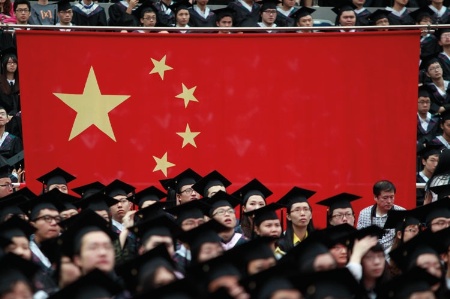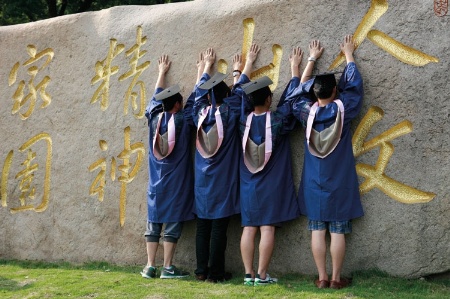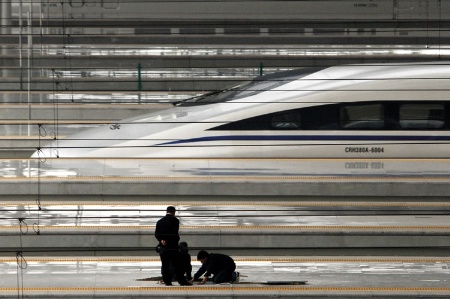Source: Reuters
The real question is how do you compete with what China is going to be and how do you benefit by collaborating?
Driving up to Shanghai’s Hongqiao railway station, reputedly the biggest in Asia, its sheer size takes your breath away. Inside, the terminus gleams like a super-modern airport, while the scale of the vast space makes it feel like a gigantic cathedral. Streams of people flow down escalators to platforms beneath, where bullet trains depart for major cities such as Beijing and Nanjing, reaching speeds of nearly 200mph on their journeys.
Built at a cost of 15 billion RMB (£1.5 billion), the station opened in 2010. It took just two years to construct. In the five years since China opened its first high-speed rail link, it has built 6,200 miles of high-speed track – more than in the whole of Europe.
With such huge resources at its disposal, is it possible for China to create world-class universities at comparable speed?
“In 2012, China’s total R&D expenditure exceeded 1 trillion RMB,” notes a recent report from UK innovation charity Nesta titled, China’s Absorptive State: Research, Innovation and the Prospects for UK-China Collaboration. It goes on to describe outgoing Premier Wen Jiabao’s end-of-term address in which he “highlighted the 18 per cent year-on-year increase in China’s research spending since 2008; a period when the after-effects of the global financial crisis have seen investment flatline or fall in many OECD countries”.
Despite the resources behind them, China’s universities are often perceived critically by the West. “I tend to be somewhat less bullish [than others] on Chinese universities joining the top ranks of global research universities in the near future,” says Philip Altbach, director of the Center for International Higher Education at Boston College. “My somewhat pessimistic views are shared privately when I talk with senior Chinese academic colleagues about their possibilities.”
He outlines a series of key issues he believes the country must address to allow its institutions to take off: “Autonomy and governance; the development of an academic culture that truly values transparency and productivity, and contributes to science as part of a basic academic mission; and the development of academic freedom.” Although China’s universities have made progress, a “glass ceiling” looms for these reasons, Altbach argues.
That reasoning is rejected by Ian Gow, principal and chief executive of the Sino-British College in Shanghai and former provost of the University of Nottingham’s campus in Ningbo. “The assumption is that you can only be a great educational and research power if you do it the American way. I think you could be proved very wrong and it may be too late when you find out,” he says.
Gow emphasises China’s talent, resources and strategy in higher education. “Chinese higher education will be a key driver in China’s quest for scientific and technological superpower status and it won’t necessarily follow Western models.…The real question is how does the West effectively evaluate Chinese university research strategies and how do Western universities gain win-wins by collaborating? To do that many of those commenting on Chinese higher education need to question their basic assumptions and try to understand a lot more about Chinese universities and their relationship with state goals,” he says.
To some, focusing on the issue of academic freedom – an almost inescapable theme in discussions in the West about Chinese universities – is to miss the point: it is similar to expecting the Chinese government to hold a planning inquiry before starting its next high-speed rail line.
China’s universities are certainly moving fast and a drive towards internationalisation, linked to a campaign to improve research quality, aims to propel the nation to the next stage of economic development.
But while the need to reform is discussed in China’s universities, the relationship between higher education and the Chinese Communist Party remains deeply, and rather intriguingly, embedded in the fabric of the sector.
Zhejiang University is a member of the C9 League, a group of China’s elite research universities, the ones that benefit from the biggest funding. The C9’s position in China is “very similar to [that of the] Russell Group in the UK”, says Zhejiang’s executive vice-president, Song Yonghua.
The university is located in Hangzhou, a city with a population of 9 million about 100 miles from Shanghai – but that’s less than an hour’s ride on a bullet train. Hangzhou is famed for its pretty West Lake, where people escape hot and hectic Shanghai to promenade by the water and maybe take part in a karaoke-style sing-song. It is a popular holiday or day-trip destination.
But there is no such sense of relaxation at the university, which is named after the region in which Hangzhou is situated. The residents of Zhejiang Province are known as the wealthiest and most entrepreneurial in China, making it a fitting location for an ambitious institution.
“The vision of Zhejiang University, together with several other [Chinese] universities, not just C9 universities but others, is to become a world-class university. The vision of that has a big impact on whatever we do,” says Song, whose experience in international higher education includes having been a pro vice-chancellor at Brunel University and at the University of Liverpool, after becoming the UK’s youngest-ever professor of engineering during his time at Brunel.
Song sets out a number of key factors that have become significant in the past 15 years for Zhejiang and other Chinese universities: the economic development that brings greater resources means that “the type of graduate the country needs is quite different from what we used to have”; globalisation; and international student mobility. Because of these, China’s society and government have “different expectations” of Chinese higher education than they did in the past, he says.

Ten years ago, we were happy with publication. Now that’s not enough. We need to produce quality papers that people will read and cite
Boosting the international credentials on Song’s CV are his time as assistant president for international affairs at Beijing’s Tsinghua University. And he is also a former chair of the government’s “1000 Talents” scheme, which provides funding to tempt Chinese nationals working as leading professors overseas to return to their homeland.
Zhejiang “is doing quite well in China”, Song says. “But to become a world-class university, to educate leaders of tomorrow, we need an international perspective.”
This drive towards world-class status is part of a government strategy – the Chinese state is injecting huge funds into a select group of institutions that it hopes will compete with leading Western institutions (see ‘Lucky numbers: China’s key strategies to bolster sector’ box on page six).
Zhejiang’s most notable project in this field is its plans for a new, 200-acre international campus, sited between Hangzhou and Shanghai, scheduled for completion by 2016 at a cost of 4.5 billion RMB.
The campus’ working language will be English (currently only master’s courses at Zhejiang are taught in English) and it will focus on building the university’s strength in selected key subject areas. It aims to attract high-achieving students and to “recruit international quality staff to do research there”, forming a “small, high-quality version of Zhejiang University, within Zhejiang University”, Song says.
Zhejiang is also building substantial links with Imperial College London. UK and Chinese media reports in May said Zhejiang would open a “campus” at Imperial’s new site in White City in West London, the former home of the BBC. Imperial describes things rather differently – its website refers to the two institutions “co-investing in a future R&D facility”.
To reach the next stage for its universities and economy, China is improving the quality of its research – an area where international links play a crucial role. Shanghai Jiao Tong University, another C9 member, claims to have the highest number of returnees under the 1000 Talents scheme.
Xiaojing Ma, associate dean of the School of Life Sciences and Biotechnology, is one such returnee. He spent 30 years outside China, first as a PhD student at the University of Edinburgh and latterly as a professor at Cornell University.
Bringing back leading professors under the 1000 Talents scheme is aimed at upgrading “China’s science and technology, with the goal of shifting the economic structure from labour-intensive, low-cost industry to high-tech intellectual property”, he says.
For those who measure research performance – including the Chinese government and the compilers of world university rankings – citation scores are vital.
Ma continues: “China hasn’t been a research powerhouse like the US. Most of the time people don’t readily recognise publications solely out of China. But if you have international collaborators, especially well-known collaborators, audiences outside China tend to read the article. Then, therefore, the chances of citing it are higher.”
Whereas “10 years ago, we were happy with publication”, now “everyone realises that’s not enough”, says Ma. “We need to produce quality papers that people will read, will cite and have potential implications for science or practical applications.”
That internationally co-authored papers tend to gain more citations is widely established in the West, but it was not realised at Shanghai Jiao Tong until relatively recently.
“The idea first came to me through a British university, Queen’s University Belfast,” says Guo Liang, deputy director of the university’s division of international cooperation.
Sir Peter Gregson, a former vice-chancellor at Queen’s, visited Shanghai Jiao Tong in 2011, Guo explains. “He mentioned there is this notion in the UK that is very popular: if you have a joint publication from overseas, then your citation will be quite high compared with only one nationality.”
For the professors lured back under the 1000 Talents scheme, it is “easy to be connected” and to co-publish internationally, Guo says.

The days of the president being able to appoint who he wants are gone. He’s got to negotiate through the party system. So it works as an internal police force
She reels off a formidable list of Shanghai Jiao Tong’s overseas collaborations: dual degrees with the University of Michigan in the US, ParisTech in France, and the University of Birmingham in the UK; a joint research centre with the Norwegian University of Science and Technology; and an exchange scheme for PhD students with the UK’s University of Cambridge.
“For this university, internationalisation is a major way of improving itself, to reach a higher standard for research,” Guo says, noting how the Michigan partnership led to reform of the curriculum for Shanghai Jiao Tong’s mechanical engineering course, after which it was rated number one in the Chinese government’s rankings in that subject.
“You have that incentive to improve yourself if you constantly compare yourself,” Guo explains.
That all conjures up a picture of international harmony. But how do the very different academic cultures of the West and China blend together?
Does Ma feel constrained by a lack of academic freedom after returning from the US? “I’m an immunologist by training – this is not political science. I can do pretty much whatever I think is important, is interesting, scientifically,” Ma says. “The issues are the financial systems: how you spend the money. The checks and balances to prevent misuse. That’s an issue that China’s grappling with. There are a lot of abuses in the system.”
Turning again to the comparison with the US, Ma says that the funder for his research there – the National Institutes of Health – would constantly revise his project outlines when he applied for funding. “After a couple of rounds of revision, I could hardly recognise my own original idea. You had to change it otherwise you wouldn’t get the funding,” he explains. “Here, they make suggestions, but they don’t really shape your research that much. There’s more freedom in that sense.”
Ma observes that “the financial problems of the US government and continuous pressures on the research budget are creating a lot of problems. We ended up being squeezed a lot in terms of how we could do our science, how we could put our ideas into actual efforts. We felt very limited by what we could do. Whereas here, they encourage you to do new things and to start new research groups.”
What is academic life like for someone working in a more politically sensitive field?
Asked about the main concerns in life for an academic, Hong Bing, an associate professor in journalism at Fudan University and a regular contributor to Times Higher Education, cites the burden of teaching, research and administration and of finding “a very difficult balance between those three factors”.
Is academic freedom restricted? “No. Some of my colleagues are doing very good research. They deal with real questions, real issues in the sector of journalism,” Hong says.
Can academics be critical of the government in their research? “It depends,” he answers. “Something you have to deal with is that most of the research projects are funded by the government. In that sense you can understand. How could you imagine that the [research] papers [could be] critical of the government? Although that depends on the language you use.”
Had Hong heard about Peking University’s recent controversial sacking of Xia Yeliang, a prominent pro-democracy advocate? “I have read some stories about that…That is actually why I love Fudan. Because no story like that happens in Fudan,” he says.
But Hong concedes that teaching journalism in a country without press freedom is “very challenging”. There is “more and more state regulation” of the press, he laments. “More and more.”
Zhejiang’s Song argues that a number of reforms are needed to take China’s universities to the next level – although when he speaks of “academic freedom” it seems to be more in the sense of greater autonomy from government, rather than the liberty to research regardless of political sensitivities.
“There are some areas where the government needs to give more freedom to the universities,” Song says.
The government has set out plans to introduce charters for a number of leading universities. Such a step would be a “big milestone”, says Song. He adds that the charter policy “tries to clarify a number of things, where we don’t know where we stand. The relationship between the university and the Ministry [of Education], central government and local government.”

The biggest obstacle to China becoming a major power in the higher education world is the culture of the universities. It’s incredibly hierarchical
He continues: “Another movement – intertwined with the charter issue – is how universities mobilise, move like a university, not a government agency.”
The government is allowing some universities to set up academic committees that play a role in governance – a step Zhejiang has already taken. In Song’s view, this move will allow “professors to have their views on how the university should be organised”.
When the C9 had its annual meeting this year in the city of Hefei, it signed up to the “Hefei statement on the 10 characteristics of contemporary research universities”, alongside the Association of American Universities, the League of European Research Universities and Australia’s Group of Eight.
Notably, the statement outlined one of the characteristics as being “the responsible exercise of academic freedom by faculty to produce and disseminate knowledge through research, teaching and service without undue constraint”.
Sceptics note the word “responsible” and suggest that the statement is window-dressing required by Western universities entering partnerships with Chinese institutions.
Song, however, calls the statement “a declaration of academic freedom”. He continues: “It is a public announcement to say that ‘we care about these things and will work together to create a better academic environment for education and research’.”
What is the meaning of “academic freedom” in the statement? Song answers: “[It means] whether you have more say for the faculty…to run the university through the academic committee. How you promote your academic staff, what criteria you use.”
In general, Song sees a parallel between higher education and reform in areas such as industry. China now needs its industry to be “more creative, innovative or high-tech. That similarly applies to higher education. It’s a different stage of development.”
China’s attempts to show a newfound commitment to academic freedom may have been undermined by the Xia case, which reinforced the impression for some that its universities remain intolerant of dissent and led to negative coverage in the Western press. In 2008, the professor of economics was among the original 303 signatories of the Charter 08 manifesto calling for democracy, civil liberties and the rule of law in China. In October this year he was sacked, with Peking University citing his allegedly poor results in teaching evaluations – a charge Xia flatly rejected.
The Wall Street Journal ran an interview with Xia and gave a typical reading of China’s universities. “The professor’s case is a window into the Chinese academic world that America’s elite institutions are so eager to join – a world governed not by respect for free inquiry but by the political imperatives of a one-party state,” the newspaper decreed.
Xia told The Wall Street Journal: “All universities are under the party’s leadership…In Peking University, the No. 1 leader is not the president. It’s the [Communist] party secretary of Peking University.”
A Communist party secretary is the head official in Chinese universities. Zhejiang’s website is clear on its key administrators: at the top is the secretary of the party committee; next is the executive vice-secretary of the party committee; after that are three vice-secretaries of the party committee; and only then is the actual university president given a mention.
This curious – to Western thinking – arrangement is explained by Mike Gow (son of the Sino-British College’s Ian Gow), who has recently completed a PhD at the University of Bristol on the relationship between Chinese universities and the state.
“The academic and the strategic side and the day-to-day running is all [done] by the president,” he says, adding that the system has been likened to company chairman (party secretary) and chief executive officer (university president).
Although Westerners may see these party officials as “looming coercive types saying ‘can do this, can’t do that’ ”, they often hold higher degrees and academic titles, says Gow, who is now global postdoctoral fellow at NYU Shanghai and writer of The Daxue Blog on Chinese higher education.
He notes that different departments within universities will have their own party secretaries, with the party secretary system responsible for administration, including student welfare and hiring of faculty. This system can provide a “check and balance”, he says, adding: “The days of the president being able to appoint who he wants are gone. He’s got to negotiate that through the party system. So it works as an internal police force against academic corruption as well.”

In 1989-92, an era marked by protests after Tiananmen Square, university party secretaries “ruled the roost completely” in the crackdown on dissent on campus, Gow says. But since then, their position has been continually weakened, and the influence and role of academics has become far more important in the universities, he suggests.
Gow rejects the typical Western view of China’s universities. “Whenever there’s an article on China it usually contains some reference to academic freedom,” he says. “This…conflates freedom of speech and academic freedom. Academics can exercise academic freedom in China to a very great degree.”
He adds: “However, in instances where an academic steps outside the academic environment to become a social activist, this becomes an issue of freedom of speech.”
Gow argues that actually “the biggest obstacle to China becoming a major power in the higher education world is the culture of the universities. It’s incredibly hierarchical.”
He describes a system of patronage, where PhD students to mid-career academics carry out much of the research while their supervising professors take the credit, amounting to “a system of indentured servitude where you have to do this to rise up the ranks”.
Through its five-year plans and massive research funding, the arms of government have strategically directed universities towards key research areas and created huge internal competition for funding among academics and universities.
The British Council in Shanghai is working hard to build links between UK institutions and Chinese counterparts. One project involves the animation industry in Hangzhou, which hosts the annual China International Cartoon & Animation Festival. The festival attracts more than 2 million visitors each year.
In the UK, hubs in the creative industries usually grow organically, attracting government support further down the line. In China it’s different. Xu Jianhua, a local government official in Hangzhou, explains that in 2005, the Chinese government got tired of seeing Japanese-made cartoons dominating animation on television and decided that China should have its own animation industry. “This is a strategic direction made by central government,” he says.
Many other cities were also trying to develop creative industries, but officials in Hangzhou created an animation festival as a platform, and the hub developed from there. Now the city’s art schools and universities are training top animation talent and UK universities are collaborating with them. The Hangzhou official cheerfully admits that they would have collaborated with US universities if they had made an approach, but the British Council nipped in first.
The Nesta report on China and innovation finds that in 2011, the UK “overtook Japan to become second only to the US in the number of its joint research publications with China”. Although this is encouraging, it is “a weak predictor of future performance, owing to the speed of change within the Chinese system”, the report continues. “For any country seeking to collaborate with China, ensuring a density and diversity of connections will be crucial, spanning the academic, research, commercial, trade and cultural spheres.”
This is why Prime Minister David Cameron and David Willetts, the universities and science minister, were in China earlier this month (the former has now been taken off the naughty step by the Chinese government, having previously offended it by meeting with the Dalai Lama).
Increased collaboration with the West is likely to bring more cultural flashpoints, if Western academics object to their institutions linking with Chinese universities perceived to score poorly on academic freedom. However, others argue that closer links may also give strength to emerging currents of reform in Chinese universities.
When asked what lessons he takes from his time in the UK, Song points to “how universities relate with the government [and] with society…We struggle with it here [in China], but they have sorted it out there.”
On the other hand, according to Song, visitors from UK universities have been bowled over by Zhejiang’s switch to a US-style curriculum on all its undergraduate courses, in which students start off studying a broad range of subjects and specialise only in their final years.
“They found it very interesting,” he says. “If they want to reform, it takes ages just to change a course. We just did it.”
The message might be: collaborate with China, or be overtaken by the bullet train.

Lucky numbers: China’s key strategies to bolster sector
The Chinese Communist Party does not go in for snappy titles for its key higher education strategies, preferring to play it by the numbers.
Project 211 is a plan to create 100 universities fit for the needs of the 21st century (“211” blends these two factors in slightly confusing fashion). The initiative, started in 1995 by the Ministry of Education, funds the institutions with the aim of raising their research standards and ensuring that they contribute to socio-economic development.
The objective of Project 985, meanwhile, is to create “world-class” universities. This scheme was announced by Jiang Zemin, who was then president, in May 1998 (in Chinese date format, that reads 98/5). It made an elite group of nine universities eligible for extra financial resources (on top of Project 211 cash). In 2004, 985 funding was extended to a total of 39 institutions.
In 2009, with the backing of the Ministry of Education, the initial nine universities selected for 985 funding formed the C9 League – a group of institutions sometimes described as China’s equivalent of the US Ivy League or the UK’s Russell Group. The C9’s members are: Peking University, Tsinghua University, Zhejiang University, Harbin Institute of Technology, Fudan University, Shanghai Jiao Tong University, Nanjing University, University of Science and Technology of China and Xi’an Jiaotong University.
There are also lucky numbers for research. The 863 and the 973 programmes of the Ministry of Science and Technology seek to boost innovation in high-tech sectors and to bolster basic research on themes of national economic and social importance.
Money, freedom and top Marx: targets are set
A combination of Marxism and reform is in store for China’s universities, according to key government plans.
For education, a key document is the government’s National Outline for Medium and Long-term Education Reform and Development (2010-2020). This sets a target for higher education enrolments to rise from 29.8 million in 2009 to 35.5 million in 2020 – an increase in gross enrolment rate from 24 per cent to 40 per cent.
The plan says that “raising quality” is key and states that by 2020 “quite a few world-famous universities with original features shall come to the fore; some of them shall have reached or approached the level of world-class universities”.
It also declares that “higher educational institutions shall also take an active part in studying and developing Marxist theories”.
On university reform, the document promises that “university/college constitutions shall be drawn up or perfected, and mechanisms explored to give full scope to the positive roles of academic committees, college councils or boards of directors.” It says that institutions “should draft their constitutions according to law…respect academic freedom and furnish a friendly and relaxed academic environment”. There is no explanation, however, of how the Chinese government defines the concept of academic freedom.
Meanwhile a report on China’s central and local government budgets, published in March by the Ministry of Finance, shows the quantity of money being invested in education. Central government spending on education rose by 15.7 per cent in 2012, it says.
“Combining all budgetary expenditures on education from central and local public finances and government-managed funds, total government education spending reached 2.1994 trillion yuan in 2012 (£221 billion), or 4 per cent of GDP,” the report adds –this percentage fulfils a target for 2012.
The UK spent 6.2 per cent of its GDP on education and training in 2009-10, but this fell to 5.6 per cent in 2012‑13, according to figures from the House of Commons Library.
Register to continue
Why register?
- Registration is free and only takes a moment
- Once registered, you can read 3 articles a month
- Sign up for our newsletter
Subscribe
Or subscribe for unlimited access to:
- Unlimited access to news, views, insights & reviews
- Digital editions
- Digital access to THE’s university and college rankings analysis
Already registered or a current subscriber?





